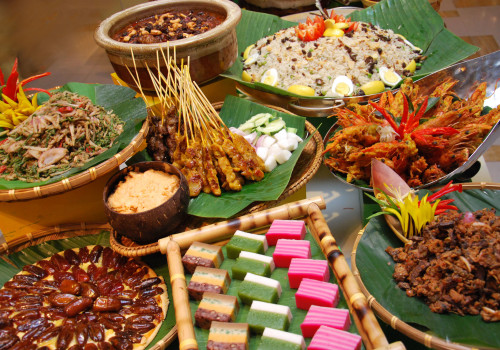
Savour : Destination Malaysia
Malaysian food is full of flavor and flair. With its diverse population, Malaysian cuisine offers a rich melting pot of flavors and ranks amongst the most delicious and tastiest in Asia. With a palate underpinned by a wide diversity of influences including Chinese, Indian and Portuguese, not to mention the many spices characteristic of South East Asian food, the country is rightly emerging as a food-lovers’ paradise – and makes for some very exciting eating!

LAKSA
No visit to Malaysia is complete without trying Peranakan/Nonya cuisine. Peranakans are descendants of early the Chinese migrants who settled in Penang, Malacca, Indonesia and Singapore inter-marrying with local Malays. The old Malay word Nyonya is a term of respect and affection for women of prominent social standing (part Madame and part Auntie), and has come to refer to the cuisine of the Peranakans.
One of the best-known and most popular Nyonya dishes is the famous Laksa noodle soup, with its rich coconut curry base. The veritable minestrone of South Asia, Laksas can feature anything tofu puffs, fish shrimps through to chicken pieces and of course, noodles and lots of delicious Asian vegetables. It’s typically served with a generous spoonful of chili paste or sambal, and garnished with coriander, or kaffir lime leaf. Laksa is the perfect winter warmer or the go-to dish when your taste buds are dying for some fresh, spicy flavors.
Ingredients
120g (2 portions) rice vermicelli
2 teaspoons vegetable oil
4 green onions, sliced diagonally (separate white and green parts)
180g jar laksa paste
1 litre chicken or fish stock
270ml can fat-reduced coconut milk
400g skinless chicken breast fillets or boneless fish fillets, finely sliced
1 red capsicum, cut into 2cm squares
200g snow peas, strings removed
1 cup fresh bean shoots, rinsed
½ bunch coriander sprigs, roughly chopped
Handful fresh mint leaves
2 limes, halved, to serve
Preparation method
- Place noodles in a bowl. Cover with boiling water. Allow to soak for 10 minutes. Drain.
- Heat oil in a wok over high heat. Stir-fry white part of onion 30 seconds. Add laksa paste; stir until fragrant. Add stock and coconut milk. Bring to the boil. Simmer 5 minutes.
- Add fillets. Simmer 2-3 minutes until just tender. Add the capsicum and snow peas and simmer 1 minute. Stir through green part of the onion, bean shoots and herbs. Squeeze a piece of lime into each serving bowl. Ladle soup over and serve.

MIE GORENG
Ubiquitous throughout Malaysia, Mie Goreng is almost the de facto national dish. This Indonesian one-dish meal favorite is made with spicy fried noodles garlic, shallots, prawn, chicken, pork, beef or sliced bakso (meatballs), chili, cabbage, tomatoes, egg, and other vegetables, and sold by everyone from street-hawkers to high-end restaurants. Order a bowl and feel like a native.
Ingredients
3 (3 ounce) packages ramen noodles (without flavor packets)
1 tablespoon vegetable oil
1 pound skinless, boneless chicken breast halves, cut into strips
1 teaspoon olive oil
1 teaspoon garlic salt
1 pinch ground black pepper, or to taste
1 tablespoon vegetable oil
1/2 cup chopped shallots
5 cloves garlic, chopped
1 cup shredded cabbage
1 cup shredded carrots
1 cup broccoli florets
1 cup sliced fresh mushrooms
1/4 cup soy sauce
1/4 cup sweet soy sauce (Indonesian kecap manis)
1/4 cup oyster sauce
salt and pepper to taste
Bring a pan of water to a boil, and cook the ramen until tender, about 3 minutes. Plunge the noodles into cold water to stop the cooking, drain in a colander set in the sink, and drizzle the noodles with 1 tablespoon of vegetable oil. Set aside.
Place the chicken strips in a bowl, and toss with olive oil, garlic salt, and black pepper. Heat 1 tablespoon of oil in a wok over high heat, and cook and stir the chicken until it is no longer pink, about 5 minutes. Stir in the shallots and garlic, and cook and stir until they start to turn brown. Add the cabbage, carrots, broccoli, and mushrooms, and cook and stir until the vegetables are tender, about 5 minutes.
Stir in the ramen noodles, soy sauce, sweet soy sauce, and oyster sauce, mixing the noodles and sauces into the vegetables and chicken. Bring the mixture to a simmer, sprinkle with salt and pepper, and serve hot.

ROTI
It is hard to ignore Malaysian cuisine’s Indian influences. Roti is one of the most popular snacks throughout the country. Often sold in Mamak restaurants or stalls, it’s a kind of flatbread made out of dough, ghee (similar to butter), egg, flour and water and watching it being made is almost as much fun as eating it! Expert Roti makers knead ingredients together, before effortlessly twirling and throwing dough up in the air, to produce huge flat discs, which are then folded and cooked. While traditionally Roti can be consumed with just about any type of curry, the most popular way for Indian Malaysians to eat it is with dhal and chili, accompanied by a variety of toppings and fillings, including eggs, banana, sardines and onion.
Ingredients
225g self-raising flour
½ tsp salt
1 tbsp vegetable oil, plus extra for brushing and frying
Preparation method
Sift the flour and salt into a large bowl. Sprinkle over the oil, and add enough water to make a soft, but not sticky, dough (about 140ml/4½fl oz) – add a little more flour or water if needed. Knead gently until smooth. Cover and leave to rest for about 30 minutes.
Divide the dough into six equal pieces and roll each one into a thin circle about the thickness of a 20 pence coin (2mm/1/16 in), using a rolling pin.
Brush the bottom third of one of the roti with oil using a pastry brush, and fold the oiled third towards the middle. Repeat with the top third, fold inwards, then turn the roti a quarter turn clockwise and repeat this process with the top and bottom third. Repeat with the remaining five rotis. Leave to rest again.
Heat a little oil in a heavy-based pan. Roll one of the roti thinly into a round with a rolling pin, and fry on one side until it puffs up and is speckled brown on the underside. Turn it over and fry on the other side for a few minutes, until it too is puffed and speckled brown. Remove from the pan, allowing the roti to cool for a few seconds, and fold into 4 and wrap in a clean tea towel placed in a colander until ready to eat.
Cook the remaining roti in the same way and serve warm.

CHAR KWAY TEOW
Originally a staple of Malaysia’s poor, Char Kway Teow has evolved into one of the country’s most loved dishes. The name is derived from the Hokkien term for ‘fried’ which is ‘char, while ‘kway teow’ refers to the ‘flat rice noodles’, which are the main ingredient. The latter are stir-fried over very high heat with soy sauce, chili, while prawns, de-shelled cockles, bean sprouts, Chinese chives and eggs. While there are many versions of this tasty dish, Penang’s Char Kway Teow tops the list when it comes to taste and originality. Not convinced? Visit Georgetown, try a plate and see for yourself.
Ingredients
80 ml oil
2 cup sausages, sliced
12 fish balls, sliced
8 spring onions, sliced
8 garlic cloves, chopped
5 handfuls fresh rice noodles, warmed
1 tbsp dark soy sauce
1 tbsp light soy sauce
24 shelled green prawns
- eggs, beaten
4 handfuls bean sprouts
1 cup chopped garlic chives
Heat the wok over high heat. When thoroughly heated, add oil, sausage, fish balls, spring onion and garlic and stir-fry for a few minutes. Add noodles and toss briefly, then add soy sauces and toss through the noodles. Scrape everything to the side of the wok and add prawns, cooking until they change color. Move the prawns to the side and add egg. Cook until the egg is nearly set, then gently fold it into the noodles. Add bean sprouts and chives, toss, and serve immediately.
![Nasi_Lemak[1]](https://retreatmag.com/wp-content/uploads/2016/01/Nasi_Lemak1-300x183.png)
NASI LEMAK
Nasi Lemak, is considered by many Malaysians to be part of their national heritage. Steam rice with Pandan leaves and coconut cream. Partner it with sizzling spicy sauce or sambal. Add generous sprinklings of roasted peanuts, salty dried anchovies and a hard-boiled egg, and eat it the traditional way – wrapped in banana leaves, to feel like a real local. Malaysians claim that Pandan leaves make all the difference between a good Nasi Lemak and an exceptional Nasi Lemak. Pandan leaves are incorporated liberally in many Malaysian dishes, infusing rice and desserts with their signature aroma. Try some Nasi Lemak yourself and taste the difference.
Ingredients
Serves: 4
1 cup jasmine rice
2 cups (500ml) coconut milk
2 pandan leaves
2 shallot
1 slice ginger
Salt to taste
Directions
Wash rice and drain.
Slice the shallots and put in pot with the rice, add coconut milk, ginger slice, pandan leaves and add a pinch of salt. Mix and cook until the rice is done.
To serve Nasi Lemak: Serve rice in the center of a plate and arrange the traditional accompaniments around the dish.
So, Food Lovers, if you can feel your tummy rumbling already, visit tourismmalaysia.com.au, be inspired and book your holiday now.





